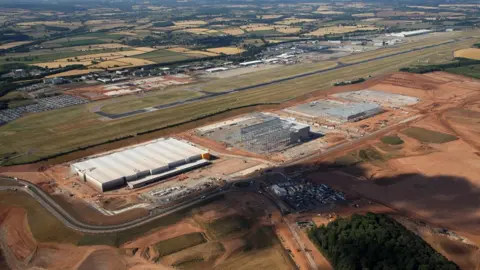Online shopping drives demand for warehousing space
The popularity of online shopping has contributed to a near doubling in demand for warehouse space over the past 10 years, according to figures from property research firm CBRE.
About 235 million sq ft of warehouse space was leased or purchased between 2007 and March 2018 - equivalent to more than 3,000 Wembley Stadiums.
That figure is up from about 130 million sq ft in the previous decade.
About 60% of the space is now used by retailers, according to CBRE.
Ten years ago, retailers accounted for about a third of the space.
"Demand has been unprecedented," said Andrew Marston, who researches UK industrial and logistics property at CBRE, which compiled the figures for the BBC.
"Growth has come from online retailers, a number of which have been rapidly expanding their distribution networks."
Discount grocery chains such as Lidl and Aldi have also played their part, he said.
In addition, warehousing space for advanced and automated manufacturing - particularly in the automotive supply chain - has taken up space.
'Golden Triangle'
One region cashing in on the opportunity is the East Midlands. The arteries of major motorways and rail connections run through Northamptonshire, Leicestershire and Derbyshire. As a result, it's rebranding itself the "Golden Triangle" of logistics.
The region has mass appeal because goods can reach 90% of the population in England and Wales within four hours.
Marks and Spencer sounded the starting pistol for the area in 2014 with its £200m fulfilment centre at Castle Donington. A little further south, Magna Park near Lutterworth is home to Disney and Asda. Tesco has a huge operation at Daventry International Rail Freight Terminal (Dirft).
 Segro
SegroDHL Express has invested more than £150m in its site in the East Midlands to make it its biggest UK operation. About 900 staff work all night long to process 190,000 packages and parcels for international businesses.
"The pace of change is incredible," says chief information officer James Holmes. "A few years ago, we would not have seen any online shipping coming through here. But now 60% of all volume is e-commerce. That's what the future is."
'Phenomenal growth'
Construction is under way of 11 mammoth units at the East Midlands Gateway, which is poised to host names such as Amazon, Shop Direct and Nestlé, as well as creating 7,000 new jobs.
Its position is largely down to the combined forces of new freight railway lines and the shift in focus by East Midlands Airport, now handling as much freight as passengers. It is the only unrestricted 24/7 airport in the country.

"The passenger flights tend to be during daytime hours, then overnight the site really comes to life with the cargo," explains Karen Smart, managing director of East Midlands Airport.
"We've seen phenomenal growth, maybe 19 to 20 planes an hour, taking cargo in or out of the country ready for that next-day delivery. It's great for business and great for the region."
Other warehousing hotspots include the M62 corridor in north-west England, and Glasgow Prestwick Airport, which is expanding to support distribution businesses.
The boom is an antidote to the High Street gloom reported in traditional retail businesses. But some may feel that the massive, grey structures looming along roadsides are no replacement for a thriving town centre.
That shift, though, is largely down to consumers themselves, who have chosen to spend more of their money online. One in five retail sales are now made from our phones or computers - and that only looks set to grow.
